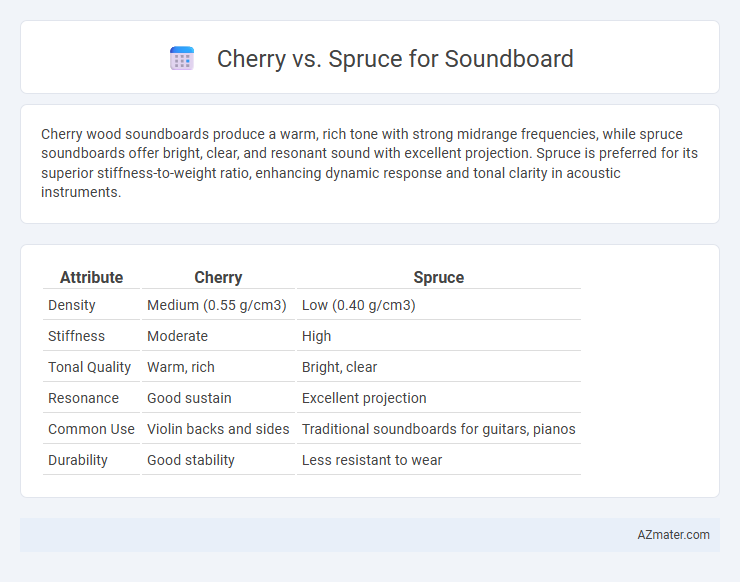Cherry wood soundboards produce a warm, rich tone with strong midrange frequencies, while spruce soundboards offer bright, clear, and resonant sound with excellent projection. Spruce is preferred for its superior stiffness-to-weight ratio, enhancing dynamic response and tonal clarity in acoustic instruments.
Table of Comparison
| Attribute | Cherry | Spruce |
|---|---|---|
| Density | Medium (0.55 g/cm3) | Low (0.40 g/cm3) |
| Stiffness | Moderate | High |
| Tonal Quality | Warm, rich | Bright, clear |
| Resonance | Good sustain | Excellent projection |
| Common Use | Violin backs and sides | Traditional soundboards for guitars, pianos |
| Durability | Good stability | Less resistant to wear |
Introduction: The Importance of Soundboard Wood
Soundboard wood significantly impacts the tonal quality and resonance of stringed instruments, making the choice between cherry and spruce crucial for luthiers and musicians. Spruce soundboards are renowned for their excellent strength-to-weight ratio, delivering bright, clear, and responsive tones favored in guitars and violins. Cherry wood offers a warmer, richer sound with enhanced midrange frequencies, appealing to players seeking a unique tonal character and aesthetic appeal in their instruments.
Physical Properties of Cherry and Spruce
Cherry wood exhibits a dense, fine-grained structure with a Janka hardness rating of about 950 lbf, providing durability and moderate stiffness ideal for soundboards requiring controlled resonance. Spruce, renowned for its lightweight and high strength-to-weight ratio, has a Janka hardness around 510 lbf, which contributes to its superior vibrational responsiveness and clarity in acoustic performance. The physical properties of cherry's density and stiffness yield warmer tones, whereas spruce's elasticity enables brighter, more projecting sound characteristics critical in high-quality musical instruments.
Tonal Characteristics: Cherry vs. Spruce
Cherry soundboards produce warm, rich, and mellow tones with enhanced midrange frequencies, offering a smooth and balanced sound ideal for jazz and folk music. Spruce soundboards deliver bright, clear, and dynamic tones with strong projection and excellent note definition, making them preferred for classical and bluegrass styles. The tonal clarity of spruce contrasts with the woody warmth of cherry, influencing the overall acoustic personality of the instrument.
Workability and Crafting Considerations
Cherry offers moderate workability with a fine, uniform texture that allows for precise shaping and finishing, making it favorable for detailed craftsmanship. Spruce, prized for its lightweight and resonant qualities, is easier to plane and carve, enabling efficient soundboard construction with excellent responsiveness to vibrations. Crafting soundboards requires balancing the hardness and grain stability of cherry against the softer, more flexible nature of spruce to optimize tonal qualities and structural integrity.
Durability and Longevity in Soundboards
Cherry soundboards exhibit strong durability due to their dense and fine-grained structure, providing excellent resistance to wear and environmental changes. Spruce, widely favored in instrument making, offers superior longevity through its exceptional tensile strength and flexibility, which help maintain tonal quality over extended periods. While spruce is often preferred for its proven resilience and consistent aging qualities, cherry soundboards can still deliver reliable performance with proper care and maintenance.
Visual Aesthetics and Grain Patterns
Cherry soundboards showcase a warm, reddish hue with tight, uniform grain patterns that enhance visual appeal and complement traditional to modern instruments. Spruce soundboards offer lighter, creamy coloration with straight, even grain lines prized for their clean, classic look and consistent resonance. The choice between cherry and spruce balances aesthetic preference for color and grain with tonal goals in guitar or violin construction.
Availability and Sustainability
Cherry wood is moderately available and sourced primarily from managed European and North American forests, ensuring a relatively sustainable supply with responsible harvesting practices. Spruce, particularly Sitka and Engelmann varieties, is widely available due to extensive cultivation in North America and Europe, offering highly sustainable options because of fast growth rates and certification from organizations like FSC. Both woods provide eco-friendly choices for soundboards, but spruce's faster regeneration and broader distribution make it a more sustainable and readily available material.
Cost Comparison: Cherry vs Spruce
Cherry soundboards typically cost more than spruce due to the wood's density and unique tonal qualities, which can add warmth and richness to instruments. Spruce is generally more affordable and widely used because of its consistent availability and exceptional resonance properties. The price difference between cherry and spruce soundboards often influences luthiers' choices depending on budget constraints and desired sound characteristics.
Popular Instruments Using Cherry and Spruce Soundboards
In popular musical instruments, spruce soundboards are favored for their exceptional resonance and dynamic range, commonly found in classical guitars, violins, and pianos. Cherry wood soundboards, while less prevalent, are valued in certain acoustic guitars and mandolins for their warm tonal characteristics and balanced midrange response. Both woods influence instrument timbre, with spruce delivering clear, bright sounds and cherry providing a softer, richer tone preferred by particular musicians.
Choosing the Right Soundboard Wood for Your Needs
Cherry and spruce offer distinct tonal qualities for soundboard wood, with spruce providing superior resonance and clarity due to its high stiffness-to-weight ratio, making it ideal for instruments requiring bright, articulate tones. Cherry, being denser and softer than spruce, imparts a warmer, mellower sound with enhanced midrange frequencies, suitable for players seeking a richer, less aggressive tone. Selecting between cherry and spruce for a soundboard depends on the desired sound projection, tonal warmth, and the specific instrument's acoustic requirements.

Infographic: Cherry vs Spruce for Soundboard
 azmater.com
azmater.com